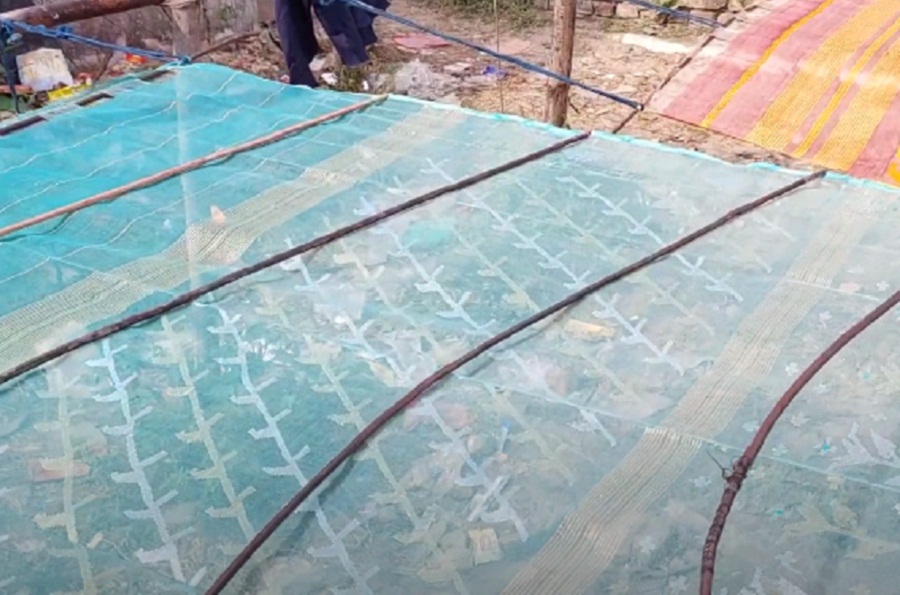
Published :
Updated :

Winter in Dhaka comes with lesser levels of heat-sourced torment, and thanks to the relaxation in the air, we breathe and walk less tiringly on the streets and roads. The same goes for sarees. Robust cotton sarees become ideal in the hotter months, as they withstand the harsh weather better and allow for greater comfort while maintaining a traditional, elegant look.
The more delicate weaved fineries like Jamdani tend to lose the tamper slightly due to exposure to the burning sun in the hot summer months of April, May, June, July, August, and September, making the cotton alternatives more suitable due to the thread robustness of the latter.
The intense heat and humidity can wear down the Halfsilk, cocoon silk-made Jamdani fabric and diminish its delicate texture.
Winter in Bangladesh generally has lower humidity than summer, and Jamdani sarees dry more easily without retaining excess moisture.
The wintery sunrays contain less ultraviolet (UV) radiation. Jamdani sarees can be worn and cared for more effectively with the gentler sun and reduced humidity in the colder months.
The lesser UV exposure means there is a lower risk of the fabric fading or its delicate threads weakening. The Jamdani saree dries faster in the winter, as there is no lingering moisture to cause mildew or odour.
Jamdani sarees are precious, and proper care is essential to protect their beauty and longevity.
Many people think dry cleaning is the best way to keep Jamdani sarees looking fresh, but that's a mistake. The delicate fabric can get damaged when Jamdani sarees are ironed after dry cleaning.
This is why the traditional katawash (or "handwash") method, performed by those who know the fabric best—the Jamdani weavers—is so effective.
Katawash involves gently washing the saree by hand to preserve its delicate threads and intricate designs. If a Jamdani saree starts to fade or loses its original look, the best way to restore it is through katawash.
Only the weavers who created the Jamdani saree know the appropriate technique to revive its original shine. They understand the fabric profoundly and can even perform minute repairs (called repo), if need be, to make sure the saree is as beautiful as ever. Since winter tends to be cold, Jamdanis need enough heat, and so is the time for regular sun soaking and katawash if required.
In the traditional kata wash process for Jamdani sarees, special tools called kata or small clippers resembling the claws of arthropod sea creatures, are used by Jamdani weavers to carefully hold the saree in its appropriate place as it hangs wide.
The saree is stretched across bamboo frames, allowing weavers to access every inch for meticulous repair. Expert Jamdani weavers then inspect the saree, identifying worn-out or misplaced threads that may have come loose with time and wear.
Using only their hands, they skillfully adjust and repair these threads, restoring the intricate patterns of the Jamdani saree with utmost care and precision.
To add a finishing touch, the saree is gently dampened with a cloth soaked in rice starch liquor. This rice starch provides a subtle crispness to the fabric, giving it the soft sheen that Jamdani sarees are celebrated for. Finally, the saree gets placed to dry in the mild winter sun, which is crucial for drying.
The sunlight helps the moisture from the rice starch to vaporize slowly, leaving the saree fresh and well-preserved. This entire process revives the saree and enhances its durability, making it ready to wear again, glowing with renewed elegance.
Winter is suitable for katawash, as the milder sun and lower humidity allow the saree to dry more evenly and quickly, with the gentle winter sun providing enough warmth to crisp up the saree after washing without exposing it to harsh UV rays, which can damage the fibres.
sofiautilitarian@gmail.com


 For all latest news, follow The Financial Express Google News channel.
For all latest news, follow The Financial Express Google News channel.